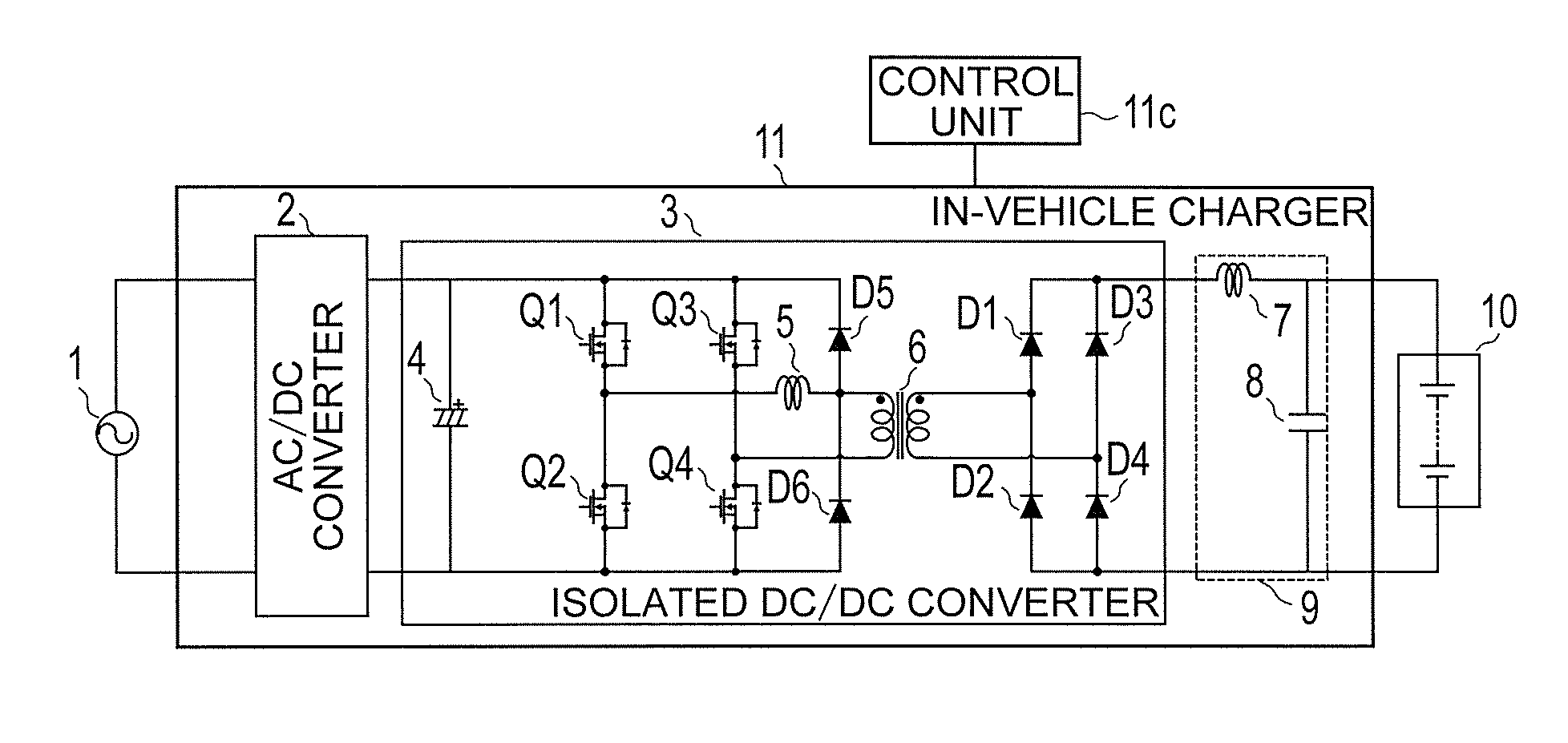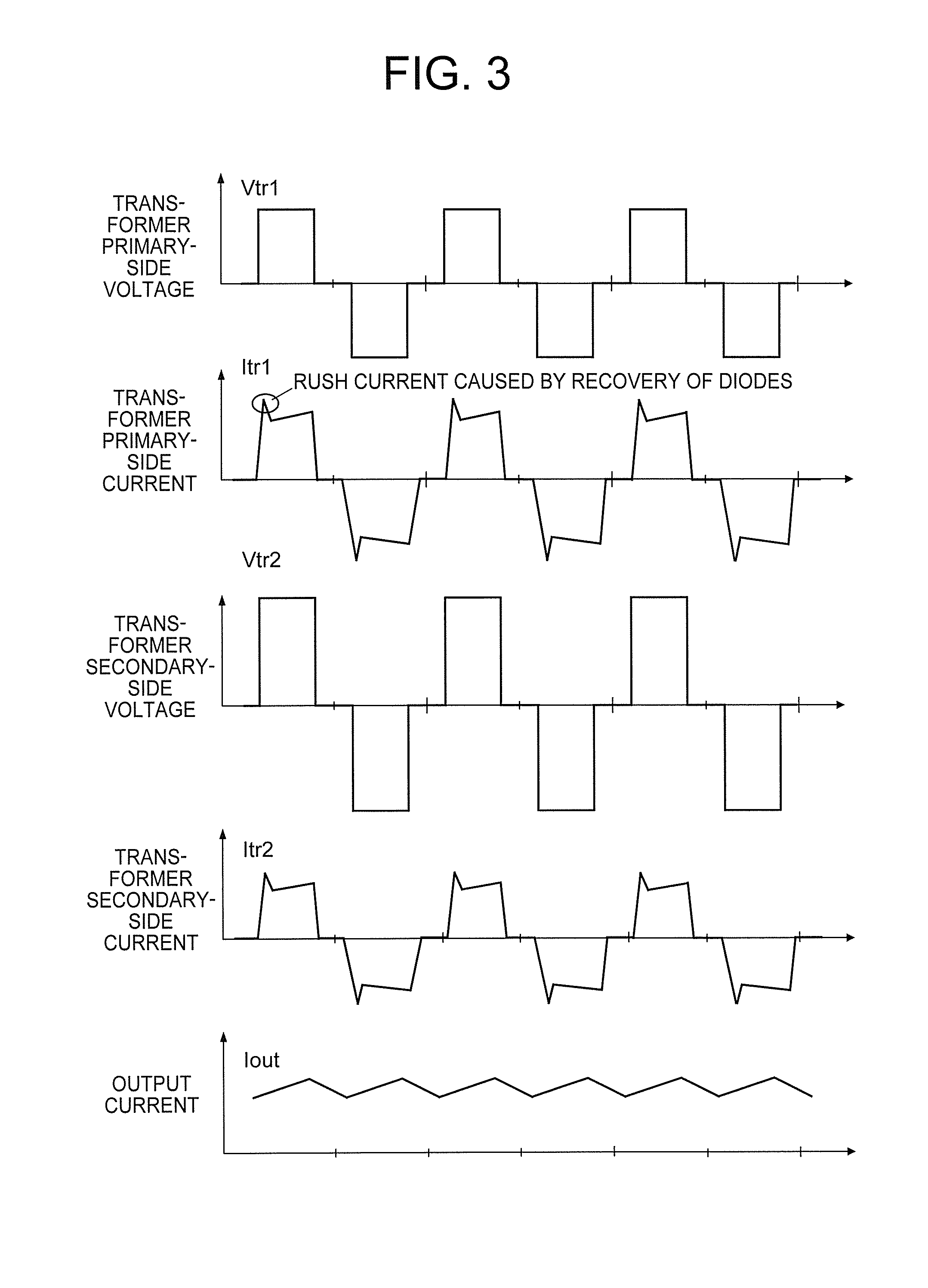In-vehicle charger and surge-suppression method in in-vehicle charger
a technology for in-vehicle chargers and surge suppression methods, which is applied in the direction of electric variable regulation, process and machine control, instruments, etc., can solve the problems of increased surge voltage, increased recovery loss of diodes, and increased withstanding voltage, so as to reduce the loss, reduce the effect of surge voltage and high conversion efficiency
- Summary
- Abstract
- Description
- Claims
- Application Information
AI Technical Summary
Benefits of technology
Problems solved by technology
Method used
Image
Examples
first embodiment
[0061]FIG. 1 is a schematic configuration diagram of an entire in-vehicle charger according to a first embodiment of the present invention. As illustrated in FIG. 1, on the input side of an in-vehicle charger 11, an AC power supply 1 (hereinafter simply referred to as “AC power supply 1”) serving as an external power supply (AC input power supply) is connected. Further, on the output side of the in-vehicle charger 11, a battery 10 having a high voltage (hereinafter referred to as “high-voltage battery 10”) serving as a load is connected. The high-voltage battery 10 supplies stored power to an electric motor for driving a vehicle.
[0062]The in-vehicle charger 11 includes an AC / DC converter 2 configured to convert an AC voltage into a DC voltage, and an isolated DC / DC converter 3 configured to step up the DC voltage generated by the AC / DC converter 2 and apply the stepped-up DC voltage to the high-voltage battery 10, to thereby supply power to the high-voltage battery 10. Further, a ca...
second embodiment
[0117]A description is now given of an in-vehicle charger according to a second embodiment of the present invention. While the switching system is described as the hard switching in the first embodiment, the configuration of the present invention can provide a greater effect by the control unit 11c carrying out phase shift control, which is the soft switching. A description is now given of this point. FIG. 13 is a schematic configuration diagram for illustrating the in-vehicle charger 11, which is the circuit portion of the in-vehicle charger according to the second embodiment.
[0118]The circuit configuration is almost the same as that of the first embodiment, but each of capacitors for resonance (hereinafter referred to as “resonance capacitors”) C1 to C4 is connected between the drain and the source of one of the semiconductor switching elements Q1 to Q4.
[0119]Each of the resonance capacitors C1 to C4 is an external capacitor, but is not limited to the external capacitor, and may b...
third embodiment
[0138]A description is now given of an in-vehicle charger according to a third embodiment of the present invention. The in-vehicle charger 11 described in the second embodiment suppresses a step-up rate of the voltage of the capacitor 4 output by the AC / DC converter 2, the control unit 11c drives the isolated DC / DC converter through the phase shift control, and the semiconductor switching elements Q3 and Q4 are caused to start to be turned on / off earlier than the semiconductor switching elements Q1 and Q2 (refer to FIG. 14), thereby increasing the possibility of establishing the ZVS. However, on the other hand, the primary-side current of the isolated transformer 6 and the surge current of the resonance reactor 5 flow through the resonance reactor 5, and the current flowing through the resonance reactor 5 is thus large (refer to FIG. 14). Further, the same current also flows through the semiconductor switching elements Q1 and Q2 during every other half cycle (refer to FIG. 15 to FIG...
PUM
 Login to View More
Login to View More Abstract
Description
Claims
Application Information
 Login to View More
Login to View More - R&D
- Intellectual Property
- Life Sciences
- Materials
- Tech Scout
- Unparalleled Data Quality
- Higher Quality Content
- 60% Fewer Hallucinations
Browse by: Latest US Patents, China's latest patents, Technical Efficacy Thesaurus, Application Domain, Technology Topic, Popular Technical Reports.
© 2025 PatSnap. All rights reserved.Legal|Privacy policy|Modern Slavery Act Transparency Statement|Sitemap|About US| Contact US: help@patsnap.com



